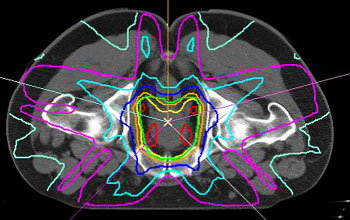Multimedia Gallery
Intensity Modulated Radiotherapy (Image 1)
Intensity Modulated Radiotherapy (Image 1)
An intensity-modulated radiation therapy (IMRT) planning algorithm operates by using the outlines of the prostate and other radiation-sensitive organs in a CT scan to arrive at matrices of beamlet intensities that are delivered from several external angles. In this case, the beamlet intensities were produced using a new algorithm based on a sensitivity analysis over a large number of previously planned patients. The algorithm produced a clinically acceptable radiation plan in about 10 minutes compared to the hours it might take a human. The automatic planning algorithm results in beamlet intensities that produce the pictured equal-dose contours. The prostate (center) receives a high amount of dose, while the nearby rectum (just above it) receives a low dose.
This work was supported in part by CenSSIS, the National Science Foundation (NSF) Center for Subsurface Sensing and Imaging Systems, NSF grant EEC 99-86821. [See related image here.] (Date of Image: 2006)
Credit: Rich Radke, Dept. of ECSE, Rensselaer Polytechnic Institute
Images and other media in the National Science Foundation Multimedia Gallery are available for use in print and electronic material by NSF employees, members of the media, university staff, teachers and the general public. All media in the gallery are intended for personal, educational and nonprofit/non-commercial use only.
Images credited to the National Science Foundation, a federal agency, are in the public domain. The images were created by employees of the United States Government as part of their official duties or prepared by contractors as "works for hire" for NSF. You may freely use NSF-credited images and, at your discretion, credit NSF with a "Courtesy: National Science Foundation" notation.
Additional information about general usage can be found in Conditions.
Also Available:
Download the high-resolution JPG version of the image. (144 KB)
Use your mouse to right-click (Mac users may need to Ctrl-click) the link above and choose the option that will save the file or target to your computer.



